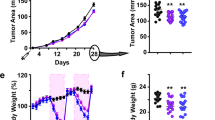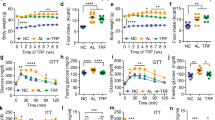Abstract
Dietary energy restriction (DER) inhibits the development of spontaneous, chemically, genetically, and virally induced mammary cancer in rats and/or mice. DER inhibits the initiation and postinitiation stages of mammary carcinogenesis and the development of both ovarian-hormone-dependent and -independent mammary carcinomas. The predominant effect of DER appears to be suppression of the clonal expansion of transformed cells, and this effect is most likely mediated via the coordinated regulation of cell proliferation, apoptosis, and angiogenesis. The effects of DER on cell cycle regulation and apoptosis are consistent with the limitation of one or more cell survival factors. Evidence is presented that the chemical mediators of this effect, glucocorticoids, insulin, and/or insulin-like growth factors, are elicited in response to the limitation in glucose availability imposed by DER. Investigation of DER is highly relevant to the misregulation of body weight which has been identified as a human health problem of global proportion. Mechanistic studies hold the promise of leading to the identification of DER mimetic approaches that can be used in the prevention and control of breast cancer.
Similar content being viewed by others
REFERENCES
D. Kritchevsky (1999). Caloric restriction and experimental carcinogenesis. Toxicol. Sci. 52:13-16.
H. J. Thompson, Z. Zhu, and W. Jiang (2002). Protection against cancer by energy restriction: All experimental approaches are not equal. J. Nutr. 132:1047-1049.
M. A. Lane, D. K. Ingram, and G. S. Roth (1999). Calorie restriction in nonhuman primates: Effects on diabetes and cardiovascular disease risk. Toxicol. Sci. 52:41-48.
M. A. Lane, A. Black, A. Handy, E. M. Tilmont, D. K. Ingram, and G. S. Roth (2001). Caloric restriction in primates. Ann. N. Y. Acad. Sci. 928:287-295.
H. J. Thompson, R. Strange, and P. J. Schedin (1992). Apoptosis in the genesis and prevention of cancer. Cancer Epidemiol. Biomarkers Prev. 1:597-602.
P. W. Sylvester, C. F. Aylsworth, D. A. Van Vugt, and J. Meites (1982). Influence of underfeeding during the “critical period” or thereafter on carcinogen-induced mammary tumors in rats. Cancer Res. 42:4943-4947.
P. W. Sylvester, C. F. Aysworth, and J. Meites (1981). Relationship of hormones to inhibition of mammary tumor development by underfeeding during the “critical period” after carcinogen administration. Cancer Res. 41:1384-1388.
D. Kritchevsky, M. M. Weber, and D. M. Klurfeld (1984). Dietary fat versus caloric content in initiation and promotion of 7,12-dimethylbenz(a)anthracene-induced mammary tumorigenesis in rats. Cancer Res. 44:3174-3177.
IARC (2002). Weight Control and Physical Activity. IARC Handbook of Cancer Prevention, IARC Press, Lyon.
Z. Zhu, A.D. Haegele, and H. J. Thompson (1997). Effect of caloric restriction on pre-malignant and malignant stages of mammary carcinogenesis. Carcinogenesis 18:1007-1012.
S. D. Hursting, S. N. Perkins, J. M. Phang, and J. C. Barrett (2001). Diet and cancer prevention studies in p53-deficient mice. J. Nutr. 131:3092S-3094S.
C. Ip (1990). Quantitative assessment of fat and calorie as risk factors in mammary carcinogenesis in an experimental model. Prog. Clin. Biol. Res. 346:107-117.
D. M. Klurfeld, C. B. Welch, M. J. Davis, and D. Kritchevsky (1989). Determination of degree of energy restriction necessary to reduce DMBA-induced mammary tumorigenesis in rats during the promotion phase. J. Nutr. 119:286-291.
Z. Zhu, W. Jiang, and H. J. Thompson (2002). An experimental paradigm for studying the cellular and molecular mechanisms of cancer inhibition by energy restriction. Mol. Carcinog. 35:51-56.
Z. Zhu, W. Jiang, and H. J. Thompson (1999). Effect of energy restriction on tissue size regulation during chemically induced mammary carcinogenesis. Carcinogenesis 20:1721-1726.
E. Lok, F. W. Scott, R. Mongeau, E. A. Nera, S. Malcolm, and D. B. Clayson (1990). Calorie restriction and cellular proliferation in various tissues of the female Swiss Webster mouse. Cancer Lett. 51:67-73.
Z. Zhu, W. Jiang, and H. J. Thompson (1999). Effect of energy restriction on the expression of cyclin D1 and p27 during premalignant and malignant stages of chemically induced mammary carcinogenesis. Mol. Carcinog. 24:241-245.
W. Jiang, Z. Zhu, and H. J. Thompson (2003). Effect of energy restriction on cell cycle machinery in 1-methyl-1-nitrosourea-induced mammary carcinomas in rats. Cancer Res. 63:1228-1234.
H. J. Thompson, Z. Zhu, and W. Jiang, (2002). Identification of the apoptosis activation cascade induced by energy restriction. In the Proceedings of AACR 93rd Annual Meeting, Volume 43, p. 514, Abst. 2552, San Francisco, CA.
J. N. McGinley, K. K. Knott, and H. J. Thompson (2002). Semi-automated method of quantifying vasculature of 1-methyl-1-nitrosourea-induced rat mammary carcinomas using immunohistochemical detection. J. Histochem. Cytochem. 50:213-222.
H. J. Thompson, J. N. McGinley, K. K. Knott, N. S. Spoelstra, and P. Wolfe (2002). Vascular density profile of rat mammary carcinomas induced by 1-methyl-1-nitrosourea: Implications for the investigation of angiogenesis. Carcinogenesis 23:847-854.
R. K. Boutwell, M. K. Brush, and H. P. Rusch (1949). The stimulating effect of dietary fat on carcinogenesis. Cancer Res. 9:741-746.
Z. Zhu, W. Jiang, and H. J. Thompson (1998). Effect of corticosterone administration on mammary gland development and p27 expression and their relationship to the effects of energy restriction on mammary carcinogenesis. Carcinogenesis 19:2101-2106.
W. Jiang, Z. Zhu, N. Bhatia, R. Agarwal, and H. J. Thompson (2002). Mechanisms of energy restriction: Effects of corticosterone on cell growth, cell cycle machinery, and apoptosis. Cancer Res. 62:5280-5287.
L. L. Pashko, and A. G. Schwartz (1992). Reversal of food restriction-induced inhibition of mouse skin tumor promotion by adrenalectomy. Carcinogenesis 13:1925-1928.
B. A. Ruggeri, D. M. Klurfeld, D. Kritchevsky, and R. W. Furlanetto (1989). Caloric restriction and 7,12-dimethylbenz(a)anthracene-induced mammary tumor growth in rats: Alterations in circulating insulin, insulin-like growth factors I and II, and epidermal growth factor. Cancer Res. 49:4130-4134.
J. C. Heuson, and N. Legros (1972). Influence of insulin deprivation on growth of the 7, 12-dimethylbenz(a)anthracene-induced mammary carcinoma in rats subjected to alloxan diabetes and food restriction. Cancer Res. 32:226-232.
N. D. Cohen, and R. Hilf (1974). Influence of insulin on growth and metabolism of 7,12-dimethylbenz(alpha)anthracene-induced mammary tumors. Cancer Res. 34:3245-3252.
R. Hilf, P. J. Hissin, and S. M. Shafie (1978). Regulatory interrelationships for insulin and estrogen action in mammary tumors. Cancer Res. 38:4076-4085.
S. L. Gibson, and R. Hilf (1980). Regulation of estrogen-binding capacity by insulin in 7,12-dimethylbenz(a)anthracene-induced mammary tumors in rats. Cancer Res. 40:2343-2348.
D. M. Klurfeld, L. M. Lloyd, C. B. Welch, M. J. Davis, O. L. Tulp, and D. Kritchevsky (1991). Reduction of enhanced mammary carcinogenesis in LA/N-cp (corpulent) rats by energy restriction. Proc. Soc. Exp. Biol. Med. 196:381-384.
F. W. Kari, S. E. Dunn, J. E. French, and J. C. Barrett (1999). Roles for insulin-like growth factor-1 in mediating the anti-carcinogenic effects of caloric restriction. J. Nutr. Health Aging 3:92-101.
N. H. Sarkar, and G. Fernandes, N. T. Telang, I. A. Kourides, and R. A. Good (1982). Low-calorie diet prevents the development of mammary tumors in C3H mice and reduces circulating prolactin level, murine mammary tumor virus expression, and proliferation of mamary alveolar cells. Proc. Natl. Acad. Sci. U.S.A. 79:7758-7762.
D. K. Sinha, R. L. Gebhard, and J. E. Pazik (1988). Inhibition of mammary carcinogenesis in rats by dietary restriction. Cancer Lett. 40:133-141.
G. S. Roth, M. A. Lane, D. K. Ingram, J. A. Mattison, D. Elahi, and J. D. Tobin, et al. (2002). Biomarkers of caloric restriction may predict longevity in humans. Science 297:811.
O. Walberg (1930). The Metabolism of Tumors, Constable, London.
W. A. Weber, M. Schwaiger, and N. Avril (2000). Quantitative assessment of tumor metabolism using FDG-PET imaging. Nucl. Med. Biol. 27:683-687.
R. L. Wahl, C. A. Henry, and S. P. Either (1992). Serum glucose: Effects on tumor and normal tissue accumulation of 2-[F-18]-fluoro-2-deoxy-D-glucose. Radiology 183:643-647.
R. L. Wahl (2001). Current status of PET in breast cancer imaging, staging, and therapy. Semin. Roentgenol. 36:250-260.
C. V. Dang and G. L. Semenza (1999). Oncogenic alterations of metabolism. Trends Biochem. Sci. 24:68-72.
M. W. Pariza and R. K. Boutwell (1987). Historical perspective: Calories and energy expenditure in carcinogenesis. Am. J. Clin. Nutr. 45:151-156.
M. W. Pariza (1986). Calorie restriction, ad libitum feeding, and cancer. Proc. Soc. Exp. Biol. Med. 183:293-298.
A. R. Tagliaferro, A. M. Ronan, L. D. Meeker, H. J. Thompson, A. L. Scott, and D. Sinha (1996). Cyclic food restriction alters substrate utilization and abolishes protection from mammary carcinogenesis female rats. J. Nutr. 126:1398-1405.
S. R. Harris, A. E. Brix, J. R. Broderson, and O. R. Bunce (1995). Chronic energy restriction versus energy cycling and mammary tumor promotion. Proc. Soc. Exp. Biol. Med. 209:231-236.
R. S. Mehta, S. R. Harris, C. A. Gunnett, O. R. Bunce, and D. K. Hartle (1993). The effects of patterned calorie-restricted diets on mammary tumor incidence and plasma endothelin levels in DMBA-treated rats. Carcinogenesis 14:1693-1696.
M. P. Cleary, M. K. Jacobson, F. C. Phillips, S. C. Getzin, J. P. Grande, and N. J. Maihle (2002). Weight-cycling decreases incidence and increases latency of mammary tumors to a greater extent than does chronic caloric restriction in mouse mammary tumor virus-transforming growth factor-alpha female mice. Cancer Epidemiol. Biomarkers Prev. 11:836-843.
C. A. Gillette, Z. Zhu, K. C. Westerlind, C. L. Melby, P. Wolfe, and H. J. Thompson (1997). Energy availability and mammary carcinogenesis: Effects of calorie restriction and exercise. Carcinogenesis 18:1183-1188.
Author information
Authors and Affiliations
Corresponding author
Rights and permissions
About this article
Cite this article
Thompson, H.J., Zhu, Z. & Jiang, W. Dietary Energy Restriction in Breast Cancer Prevention. J Mammary Gland Biol Neoplasia 8, 133–142 (2003). https://doi.org/10.1023/A:1025743607445
Issue Date:
DOI: https://doi.org/10.1023/A:1025743607445




